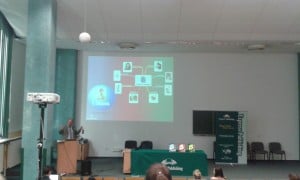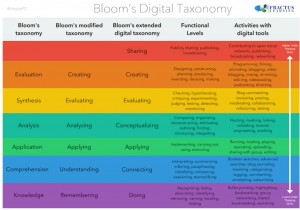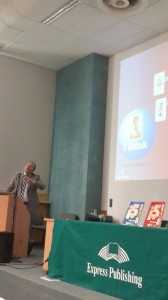“I think, I feel, I learn”: Reflections on the session by George Kokolas
It was a bright and breezy Sunday morning in Lublin, Poland. Although it was the last day of the 23rd International IATEFL Poland Conference, there were plenty of enthusiastic teachers hustling on the corridors of Uniwersytet Przyrodniczy and eager to ‘devour’ knowledge on the latest developments in the field of ELT. I was one of them… The last day of the conference, I had the wonderful opportunity to attend George Kokolas’ presentation “I think, I feel, I learn”.
The seminar focused on ‘understanding the thinking processes of students, based on their age and cognitive development, and identifying them according to Bloom’s Taxonomy’ (George Kokolas). Kokolas also analysed some of the most common thinking types and concluded his seminar by giving examples of useful EFL activities that can used in classroom ‘to help students practise the target language in a creative and inspirational manner.’ (George Kokolas)
At the very beginning of his presentation Kokolas stated that students, particularly children and teenagers, need to develop their critical thinking skills. What do we mean by critical thinking? According to the National Council for Excellence in Critical Thinking, ‘critical thinking is the intellectually disciplined process of actively and skillfully conceptualising, applying, analysing, synthesising, and/or evaluating information gathered from, or generated by, observation, experience, reflection, reasoning, or communication, as a guide to belief and action.’ (criticalthinking.org) Living in the Age of Distraction, which provides people with a plethora of ready-made and easy to digest information, can steadily lead to the loss of cognitive abilities. In terms of education, this means that students lose their ability to interpret information, judge, experiment, and produce. However, critical thinking skills are not only required in a classroom environment, but they can be extremely important in daily life, too. Therefore, it is imperative to educate students how to think analytically and critically in order to develop themselves and contribute positively to the society in which they live.
An interesting part in Kokolas’ presentation was the analysis of Bloom’s Taxonomy:
Bloom’s Taxonomy, named after Benjamin Bloom, is an attempt to classify forms and levels of learning by categorising them in three domains: the cognitive, the affective and the psychomotor domain. According to this taxonomy, a lower level of thinking involves knowledge, comprehension and application, whereas a higher level of thinking requires analysis, synthesis and evaluation. It is highly important to cultivate to students the skills to analyse, synthesise, and ultimately evaluate through a wide range of activities that can be provided by the teacher. Fortunately for all the ELT teachers, there is a plethora of activities that can enhance the students’ cognitive skills in and out of the classroom.
How is the above-mentioned taxonomy related to what teachers should do in the classroom? To answer this, Kokolas shared with the audience some precious rules that teachers need to follow:
- Determine learning objectives.
- Teach through questioning.
- Practise before you assess.
- Review, refine, and improve.
- Provide feedback and assessment of learning
In the second part of his presentation, Kokolas analysed the most common thinking types that teachers encounter in a classroom environment. These types can be divided into analytical, practical, creative, convergent and divergent, and finally vertical and lateral thinkers:
Analytical thinkers
Many mathematicians and scientists belong to this type. ‘Analytical thinkers loathe contradictions and illogicalness; with their sharp intellect, they quickly and comprehensively grasp patterns, principles and structures. […] their ability to concentrate is more marked than that of all other personality types. They are open for and interested in new information.’ (ipersonic.com) Analytical thinkers require studying long texts and can deal well with a large number of vocabulary items. What teachers can do with students who belong in this thinking type? During a grammar lesson, for instance, they can encourage them to read the examples of a new grammatical phenomenon that is introduced, and elicit information on how this can be used in the target language.
Practical thinkers
‘Practical thinking is not concerned with gathering additional information, […] but rather using or applying knowledge effectively to guide some action and solve problems.’ (education-portal.com) Teachers dealing with practical thinkers can assign various tasks that focus on the use of “everyday English”.
Creative thinkers
Creative thinking does not involve solely the ability to think out of the box and generate ideas. It also includes the ability to test new ideas, validate them and implement them in real life. Students who belong to this thinking type can be involved in creative and interactive activities, such as story writing and the presentation of it to the class.
Convergent and Divergent thinkers
‘Convergent thinking is a term coined by Joy Paul Guilford as the opposite of divergent thinking. It generally means the ability to give the “correct” answer to standard questions that do not require significant creativity, for instance in most tasks in school and on standardised multiple-choice tests for intelligence.’ Convergent thinkers seek for speed and accuracy. They also tend to use logical arguments.
On the other hand, divergent thinking ‘is a thought process or method used to generate creative ideas by exploring many possible solutions. […] Divergent thinking typically occurs in a spontaneous, free-flowing manner.’ (Strategies of Divergent Thinking, faculty.washington.edu) According to Kokolas, divergent thinkers see many possible answers to questions, and have the need to elaborate on them.
For this thinking type, teachers can ask students to be involved in “make a list” tasks and either presenting them to the class or having a discussion with a partner.
Vertical and Lateral thinkers
For the last thinking types, it can be said that vertical thinkers are very logical and analytical, while lateral thinkers enjoy solving problems following a creative approach. Teachers, can incorporate into their teaching, activities that refer to the above-mentioned thinking types, such as analytical, creative, convergent and divergent thinkers.
Kokolas concluded his presentation by referring to the importance of emotions. He stated that ‘positive memories create positive emotions, and positive emotions always lead to a positive attitude.’ Some ways to help students manage their emotions are the following:
Develop Social Competence: Success in the social world will help with positive regard for oneself and positive emotions and feelings.
Play to student’s strengths: The best way to build a student’s confidence and self-esteem is through engaging activities where they are competent.
Build in Reasonable Expectations: Students get overwhelmed when the workload seems unmanageable. Break down tasks to manageable pieces.
Awareness of Emotions: Assist students in identifying their emotions.
Managing our Emotions: Once we recognize our emotions we can implement strategies to gain better control.
In order to create a positive learning environment, the implementation of various types of activities in the classroom is more than advisable: jokes, games, role play discussions, songs, films (with a specific learning purpose) can increase the motivation of the students and therefore, facilitate the learning process.
Consequently, incorporating games into our teaching is not a waste of time, but rather imperative as games develop:
- Attention
- Situational awareness
- Multidimensional visual-spatial skills
- Inductive discovery
- Attention deployment
- Creative problem-solving
- Calculated risk-taking
- Persistence
- Attention to detail
In summary, what was the golden equation of this wonderful and very informative presentation?
“I think (critical thinking skills) + I feel (emotions) = I learn!”
Thank you Mr Kokolas!
Eirini Gkora for the ScOLa CPD Team




Thank you for this post which was quite illustrative and mentioned some new perspectives of looking at different thinking styles. I believe it could be useful once we get used to analysing ourselves first, and then maybe the close circle of friends and colleagues around us. Interesting pieces of information.